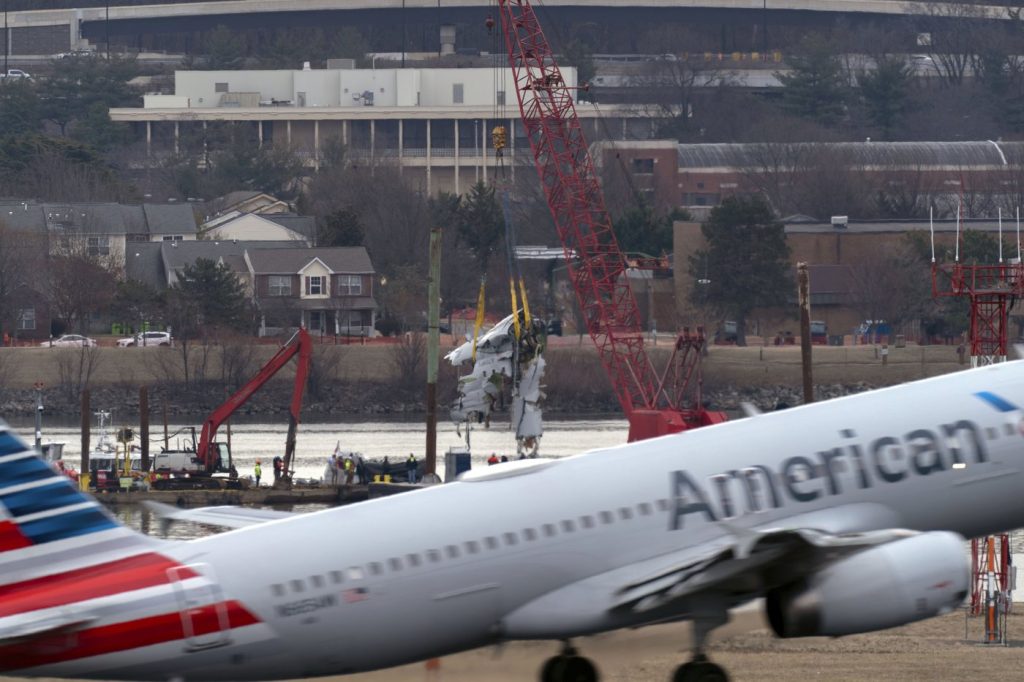Nearly a week has passed since a tragic midair collision occurred near Washington's Ronald Reagan National Airport, resulting in the deaths of 67 people. This incident marks the deadliest U.S. air disaster since 2001, involving an American Airlines jetliner and an Army Black Hawk helicopter.
As salvage crews diligently remove wreckage from the Potomac River, investigators are working to uncover the causes of the collision. The timeline of events leading up to and following the crash reveals critical details about the incident.
January 29
At approximately 8:15 PM, American Airlines Flight 5342, carrying 64 individuals, commenced its initial descent into Reagan National Airport. By 8:43 PM, air traffic controllers instructed the pilots to switch from landing on Runway 1 to Runway 33. Meanwhile, the Army Black Hawk helicopter, referred to as PAT25, was flying south over the Potomac River in clear weather conditions.
At 8:46 PM, controllers informed the Black Hawk crew that the passenger jet, designated as CRJ, was at an altitude of 1,200 feet and approaching Runway 33. As the two aircraft closed in on each other at 8:47 PM, the controller advised PAT25 to maintain visual separation from the CRJ. The helicopter crew confirmed they had the jet in sight and received approval to proceed. Just twenty seconds later, a loud commotion was captured over the radio, followed by a flash in the sky, as both aircraft tragically fell into the Potomac River. Calls for assistance quickly flooded the radio airwaves.
In the immediate aftermath, emergency responders deployed helicopters and inflatable boats to search for survivors.
January 30
The following morning, President Donald Trump addressed reporters, confirming there were no survivors and expressing uncertainty about the cause of the collision. As the names of the victims began to be shared online through social media tributes, recovery operations progressed. By midday, the bodies of all three soldiers onboard the helicopter had been retrieved. Meanwhile, Dean Naujoks, a local patrolling the Potomac, discovered various debris, including flight manual pages and plane fragments, which he submitted to the FBI.
Later that evening, authorities recovered the airplane's cockpit voice and flight data recorders for further analysis.
January 31
Amid rainy conditions, police boats continued the search for victims while investigators scoured the area for clues. Officials revealed that the Black Hawk's black box had also been obtained, and they were reviewing the flight data, focusing on the actions of the military pilot and air traffic controllers. More than 300 responders were on-site, and by the end of the day, the remains of 41 individuals had been found. The Army publicly identified two of the deceased soldiers: Staff Sgt. Ryan Austin O’Hara, 28, and Chief Warrant Officer 2 Andrew Loyd Eaves, 39.
February 1
As the rain subsided, recovery operations continued, supported by a Coast Guard cutter equipped with a crane. Investigators addressed a discrepancy observed in altitude data between the helicopter and the airliner. They expressed hopes that the helicopter's black box could provide further insights, though retrieval was delayed due to water damage.
The Army identified the third soldier killed in the incident as Capt. Rebecca M. Lobach, who was remembered fondly by friends.
February 2
By this date, officials announced that the number of recovered remains had risen to 55, promising that the remaining bodies would be located eventually. Salvage teams began preparations to lift wreckage from the river, emphasizing their commitment to adhering to strict protocols during the recovery process to ensure dignity for victims' remains.
February 3
Salvage crews successfully retrieved significant portions of the wreckage, including an engine and large fuselage sections from the airliner. Families of the victims gathered along the banks of the Potomac River to mourn their loved ones.
February 4
In the early hours, crews managed to raise additional substantial pieces of the aircraft, including the right wing and parts of the fuselage, contributing to the reconstruction of the sequence of events. Investigators announced they were examining new data that could clarify the altitude discrepancies noted earlier. Ultimately, authorities confirmed that all 67 victims had been accounted for, with nearly all remains identified.










